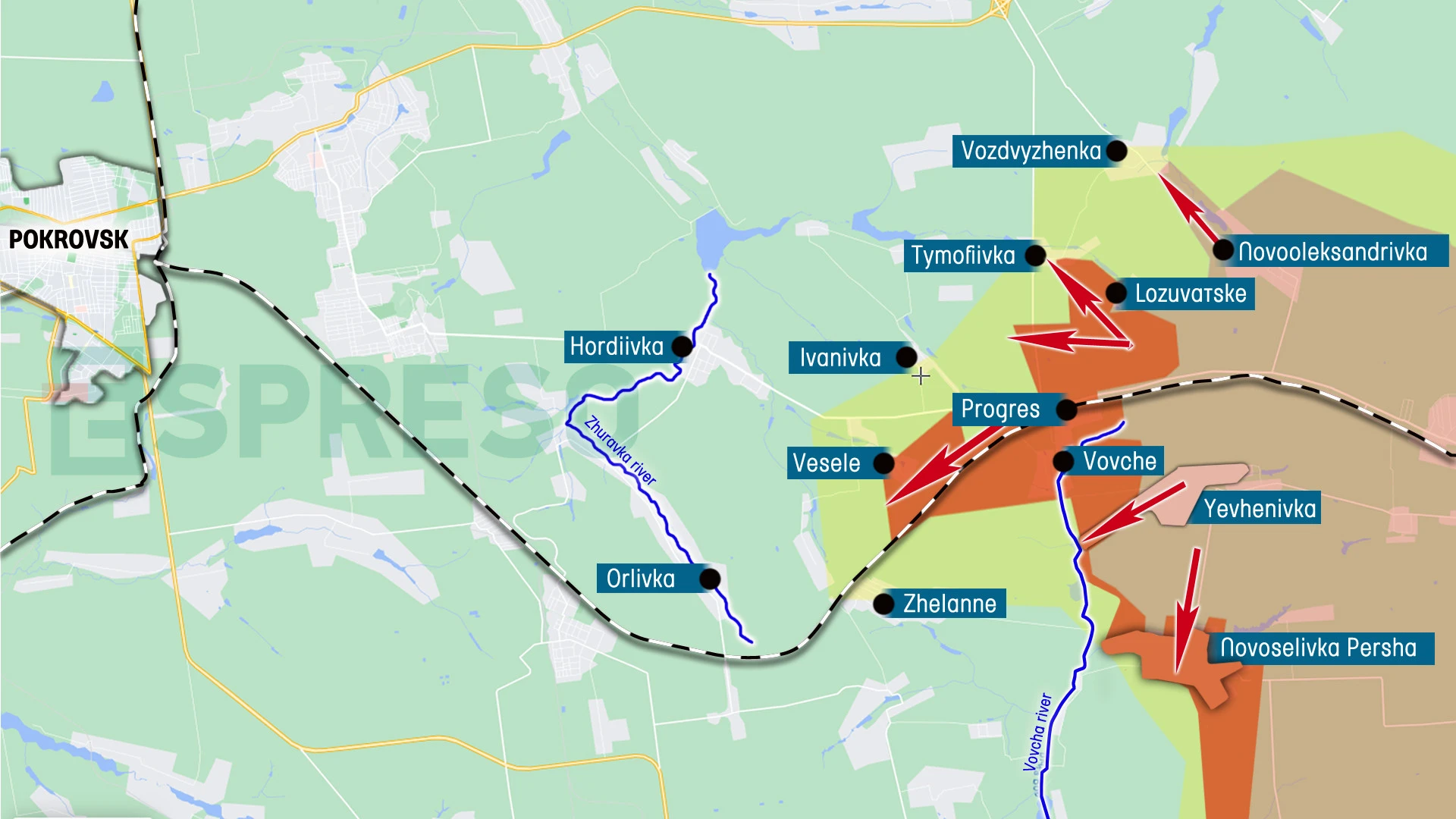
July 24-31 live war map: Russian troops advance to Pokrovsk, mount offensive in Kurakhove sector
Out of 11 frontline areas, Pokrovsk, Toretsk and Kurakhove saw over 500 combat engagements, or more than half of all fighting, demonstrating the seriousness of Russia's intentions to capture these key towns in Donetsk region this year
The intensity of the fighting is not decreasing, but rather escalating. This is clearly evident from the number of enemy forces destroyed in July, when the Ukrainian Armed Forces set several new all-time records in this war. First of all, it is worth paying attention to what exactly Ukrainian heroes are destroying, namely artillery, drones and vehicles. In recent months, the Russian troops have been sparingly using armored vehicles, not along the entire front line, but in areas where they plan breakthroughs.
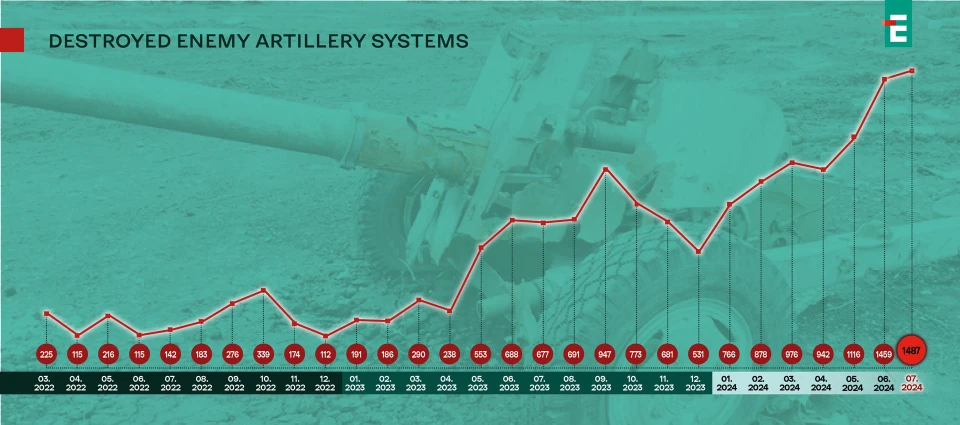
The Ukrainian Armed Forces managed to destroy almost 1,500 artillery systems and continued the trend of June. Obviously, the hunt for artillery has been prioritized in order not only to reach parity in terms of shelling, but also to create a shortage of guns. This will significantly weaken the offensive potential of the occupying Russian army. The second area of Ukrainian army's efforts is consistently a blow to the logistics capabilities of the Russian forces - in July Ukraine destroyed more than 2000 (!) vehicles. The graph shows how much the Ukrainian Armed Forces have stepped up their work in this area since March this year.
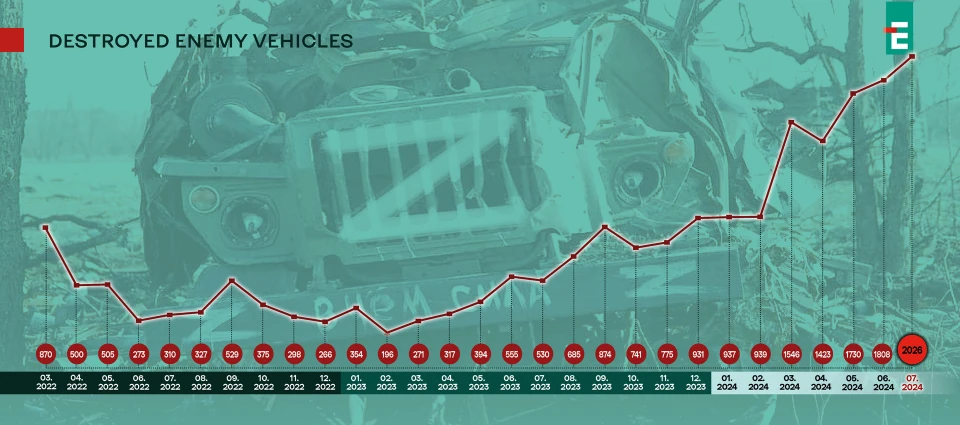
As for the UAVs, this war has actually turned into a war of drones, and therefore the tendency to increase drone strikes and their destruction will only grow. In July, Ukrainian defenders downed 1,230 operational and tactical drones. At the same time, as reported by the General Staff, only last week the Defense Forces shot down about 8,000 UAVs of various sizes and configurations using electronic warfare. This demonstrates the level of intensity of the arms race in this particular direction.
In the Kharkiv and Luhansk regions, the enemy conducted local offensives and focused on regrouping its forces. The front line has not changed. At the same time, it is clear that the Russian forces are preparing a new offensive on Vovchansk and Kupiansk. They are launching missile attacks on bridges and pontoon crossings across the Oskil River to reduce Ukraine's logistical ability to supply the Defense Forces with ammunition on the left bank of the river.
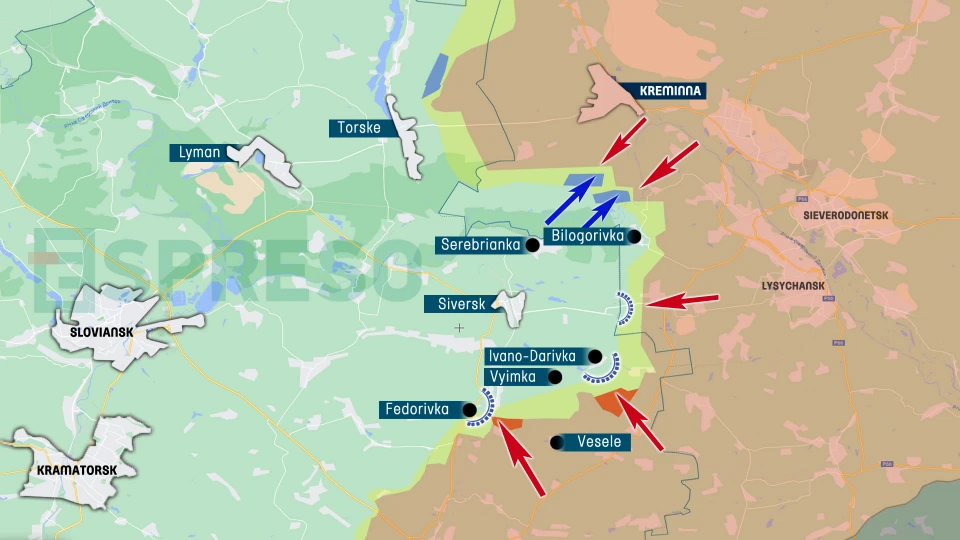
Siverskyi ledge is under threat
In this area, the Ukrainian Armed Forces continue to hold back the enemy from the east and conduct local counteroffensives in the north in the Serebryansky forest. Meanwhile, in the south, the occupying Russian forces have been making progress for weeks in a row. This time, they expanded their zone of control near Rozdolivka and also made their way one kilometer north near Spirne. If the Russian troops continue to move north in this area, Ukrainian troops defending the eastern flank may find themselves under a double attack, which will significantly complicate the defense.
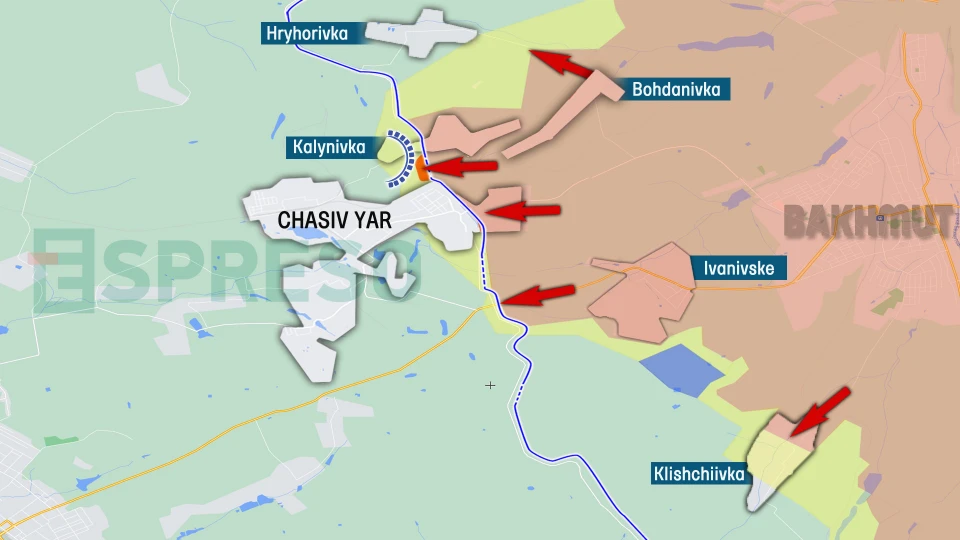
Chasiv Yar - breakthrough beyond the canal
To the north of the town, near the village of Kalynivka, where the Siverskyi Donets Canal goes underground, the Russian occupiers managed to cross this line, gain a foothold on the right bank and launch an assault on the Zhovtnevyi district, which is dominated by low-rise buildings. It is much easier to burn and destroy it than the reinforced concrete of high-rise buildings. This crisis could be the beginning of a large-scale assault on the town from the southern flank, where the Ukrainian Armed Forces are currently holding strong.
Battle for Toretsk and New York
The situation in New York has mostly stabilized. After the invading Russian forces entered the southern districts of the town and took over the area near the railway station in the central part, the Defense Forces managed to repel all attacks on the town and took up a line of defense along the local river that flows in the middle of the town. The industrial zone in the northwestern part of New York is completely under Ukrainian control, which gives us a significant advantage. Meanwhile, the Russian troops, who have made a potentially vulnerable breakthrough to New York, which is 4 km long and only 2 km wide, are trying to expand their control zone and bypass Ukrainian positions from the right flank, but so far without progress.
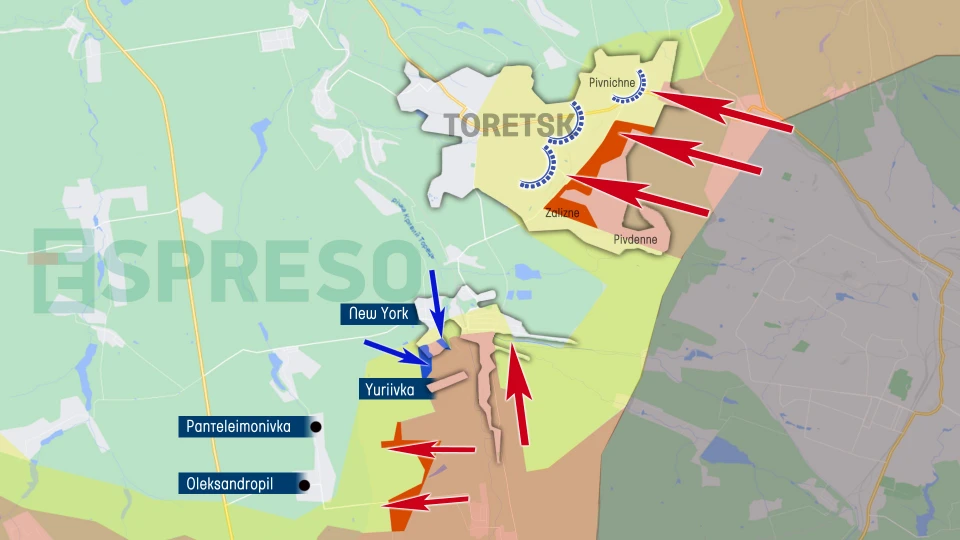
Instead, on the left flank, some of Ukraine's formations may be at risk of encirclement, as the Russian force are advancing in their rear, moving along the outskirts of Toretsk, in particular, in the area of Zalizne and Pivdenne. If they continue to advance westward toward Nelipivka, Ukrainian troops defending the eastern and eastern-southern outskirts of New York will be under attack from the north, and the defense of the town will have to be significantly curtailed.
In Toretsk, the Russian military approached Central Street, occupying all the neighborhoods to the east of it. The Pivdenne neighborhood and a large part of Zalizne were completely occupied. However, the two spoil heaps on the other side of the street provide a great advantage for the Defense Forces in deterring the offensive. In recent days, Toretsk has been stormed more than 2 dozen times daily. It is known that some Russian assault units managed to get behind the defense line, but were later destroyed.
Pokrovsk hell
From Avdiivka to Pokrovsk is 43 kilometers in a straight line. In six months, the Russian forces have managed to move 25 kilometers. In addition, in recent weeks, the speed of their advance has increased to 1-2 km per week. They are moving most rapidly along the railroad. This is how they entered Ocheretyne first, and then Progress and Vesele. The railroad goes around rivers and water bodies or over them, so the Russian Armed Forces do not need to make additional efforts to force them. Thus, in a week, the Russian troops made their way 2.5 kilometers from Progress between the Vovcha and Kazennyi Torets rivers and seized the village of Vesele. In doing so, they entered the rear of the defense line that the Ukrainian Armed Forces had built along the Vovcha River. At the moment, if they continue to move along the railroad tracks and continue to avoid water bodies and defense lines, they will be 22 kilometers away from the outskirts of Pokrovsk.
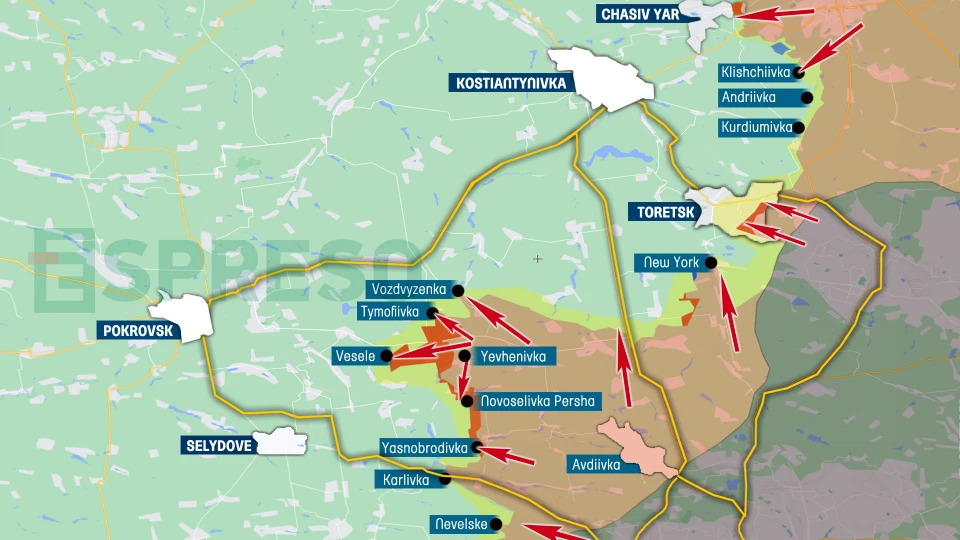
At the same time, focusing on advancing on Pokrovsk, the Russian forces slowed down their attack on Vozdvyzhenka and cutting the Pokrovsk-Kostiantynivka road.
To the south, the enemy completed the occupation of Novoselivka Persha, entered Yasnobrodivka and expanded its control zone near Umanske, thus continuing to push our soldiers to the right bank of the Vovcha River.
Kurakhove direction and occupation of Krasnohorivka
The Russian military concentrated and launched an offensive in the Kurakhove direction with a significant resource of armored vehicles. From 40 to 57 pieces of equipment were used in the attacks on different days: tanks, armored fighting vehicles and armored personnel carriers. However, the enemy suffers significant losses due to the offensive, which is mostly conducted in open terrain. In particular, as reported by the General Staff, the Defense Forces destroyed or damaged 55 units of armored vehicles over the week. However, the Russian forces are not stopping.
To a large extent, they were encouraged by their success in Krasnohorivka, where they have actually seized the town. Although Ukrainian troops are still fighting on the northern outskirts, our positions in the town are gone. Ukrainian troops have moved to the other side of the local Lozova River, where they will hold their positions. These events were also preceded by massive assaults with armored vehicles. Soon, the battle for the small village of Nevelske, where the Ukrainian Armed Forces have been holding the line for several years, will begin on this section of the front.
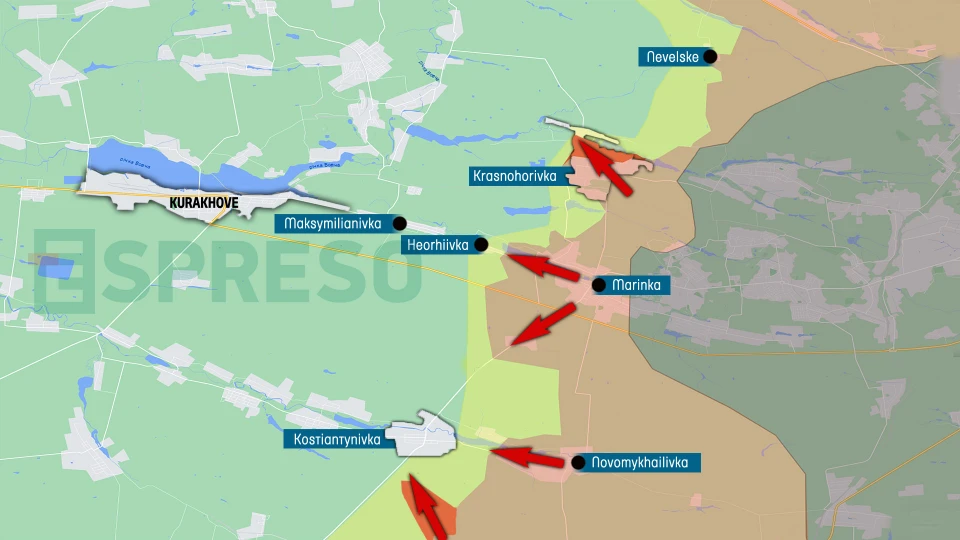
Further south, advancing on Kurakhove from Maryinka, the occupation Russian forces have been unable to break through Heorhiivka for a long time, and further south, the Ukrainian Armed Forces are holding the defense of Kostiantynivka and Paraskoviivka. In addition to frontal assaults, the Russian forces are also trying to outflank these villages. This week, they managed to push through Ukrainian redoubts south of Kostiantynivka and continued to move along the Solodka River. Thus, they came closer to cutting one of the roads leading to Vuhledar. In this area, the distance from the breakthrough point to the road is 1.2 km. In other areas of the advance, this distance varies from 2 to 4 km. If the road is cut, the Russian forces will be able to continue moving westward to surround Vuhledar. At the same time, as the Defense Forces have repeatedly proved on the Kurakhove and Vuhledar directions, the Russians may soon run out of armor, and the offensive may be stifled and the front may stabilize again.
Strikes on Crimea and Russia, new record for hit range
The Ukrainian Armed Forces continue to strike at Russian airfields, as well as energy and fuel infrastructure in the southern region of Russia.
As a result of a missile strike on the Saki airfield near Novofedorivka, three Su-30SM fighters and a Nebo-M radar were confirmed destroyed. Another ATACMS strike on the S-300 air defense battery located near Dzhankoy destroyed not only the air defense system, but also the repair base where it was located.
On the night of July 27, Ukrainian UAVs flew a record distance of 1,800 kilometers and hit the Olenya airfield in the Murmansk region. At the same time, the Ukrainian Armed Forces struck Engels airfield in Saratov region and Diagilevo airfield in Ryazan region, as well as Mozdok airfield in North Ossetia. From all of these airfields, the Russian forces launch aircraft with cruise missiles on board. While Ukraine is not allowed to hit Russia's territory with ATACMS, the Defense Forces are doing it with domestic missiles. Last night, the Neptune missiles flew over 100 kilometers and hit two warehouses with jet fuel and ammunition at an airfield near Kursk.
Strikes on airfields where helicopters are stationed are a new development. For example, Ukrainian drones destroyed one Ka-226 and two Mi-28s at the Chkalovsky airfield near Moscow, and another Mi-8 at the Kryazh airfield near Samara.
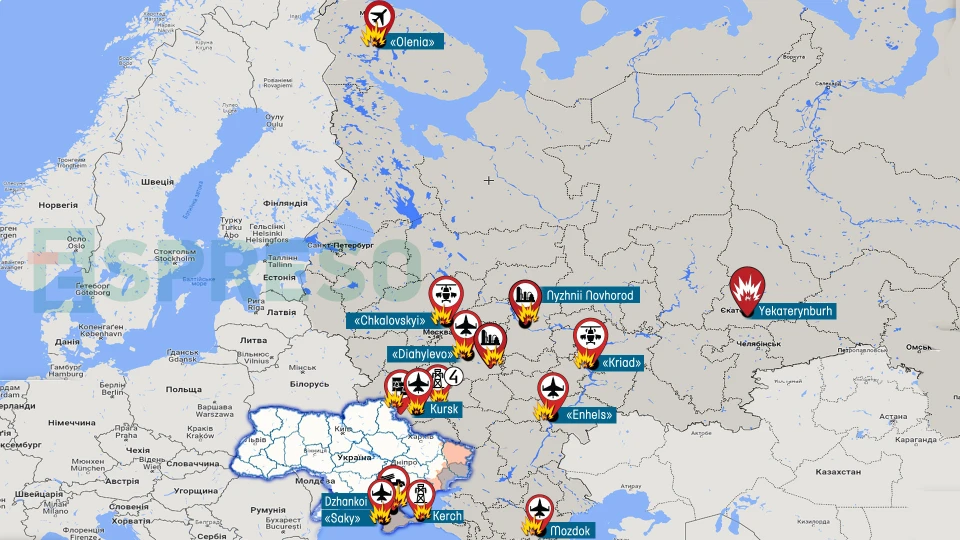
In the Ryazan and Nizhny Novgorod regions, drones hit local refineries, and in the Kursk region, they burned down an oil depot. In the Kursk region, Ukraine hit at least 4 traction power substations, which resulted in significant power outages in 3 districts of the region.
After the saboteurs' work, a total blackout occurred in Crimea after a series of fires at 4 power substations. More than 50,000 people were left without electricity in Kerch and the surrounding area, and the eastern part of the peninsula was left without water supply.
The Special Operations Forces probably marked their day with another sabotage. One way or another, a massive fire broke out in Yekaterinburg at one of Russia's largest enterprises, the Semikhatov Automation Research and Production Association, which develops controls for ballistic missiles.
The maps were created based on information received from the Ukrainian Armed Forces’ General Staff and other open and verified sources. At the same time, the maps are not as accurate as possible and only conditionally reflect trends in the combat zone.- News






